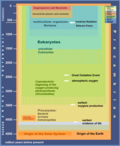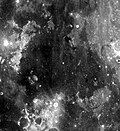The pre-Nectarian period of the lunar geologic timescale runs from 4.533 billion years ago (the time of the initial formation of the Moon) to 3.920 billion...
9 KB (464 words) - 09:58, 24 January 2024
The Nectarian Period of the lunar geologic timescale runs from 3.920 billion years ago to 3.850 billion years ago. It is the period during which the Nectaris...
3 KB (127 words) - 03:04, 7 July 2024
Lunar geologic timescale (section Pre-Nectarian)
Copernican, Eratosthenian, Imbrian (Late and Early epochs), Nectarian, and Pre-Nectarian. The boundaries of this time scale are related to large impact...
13 KB (1,514 words) - 05:54, 24 January 2024
impact crater on the Moon that dates from the pre-Nectarian era. (Older sources state that it is Nectarian in age. ) It is located on the lunar highlands...
18 KB (1,544 words) - 07:55, 18 August 2023
Noachian period is uncertain but probably corresponds to the lunar Pre-Nectarian to Early Imbrian periods of 4100 to 3700 million years ago, during the...
45 KB (5,090 words) - 00:48, 28 June 2024
Genesis Rock (category Pre-Nectarian)
surpassing it. It is still an extremely old sample, formed during the Pre-Nectarian period of the Moon's history. Dating of pyroxenes from other lunar anorthosite...
5 KB (449 words) - 03:04, 13 July 2024
South Pole–Aitken basin (category Pre-Nectarian)
estimated that it was formed 4.2 to 4.3 billion years ago, during the Pre-Nectarian epoch. It was named for two features on opposite sides of the basin:...
16 KB (1,786 words) - 14:07, 25 June 2024
Mare Tranquillitatis (category Pre-Nectarian)
to be of the Lower Imbrian epoch, but the actual basin is probably Pre-Nectarian. The basin has irregular margins and lacks a defined multiple-ringed...
12 KB (1,171 words) - 14:54, 20 July 2024
half. To the southwest of Schiller is the Schiller-Zucchius Basin, a Pre-Nectarian basin (peak ring basin). This basin has received the unofficial designation...
8 KB (550 words) - 02:42, 26 January 2024
Mare Nubium (category Pre-Nectarian)
The basin containing Mare Nubium is believed to have been part of the Pre-Nectarian system. The mare material is of the Imbrian and Eratosthenian age. Bullialdus...
4 KB (356 words) - 04:44, 19 February 2023
Origin of the Moon (category Pre-Nectarian)
The origin of the Moon is usually explained by a Mars-sized body striking the Earth, creating a debris ring that eventually collected into a single natural...
30 KB (3,406 words) - 19:33, 16 July 2024
System. To the northeast of Zucchius is the Schiller-Zucchius Basin, a Pre-Nectarian basin (peak ring basin). This basin has received the unofficial designation...
7 KB (479 words) - 01:42, 26 January 2024
Late Heavy Bombardment (category Pre-Nectarian)
initially was much larger than the current main asteroid belt. Most of the pre-Imbrium impacts would have been due to these Mars-crossing objects, with...
44 KB (5,482 words) - 15:54, 6 August 2024
closeup images of the Moon's surface. The basin material is of the Pre-Nectarian epoch, while most of the basaltic mare material is of the Upper Imbrian...
6 KB (672 words) - 15:28, 1 June 2023
Cryptic era and the following Basin Groups era for the Moon (see also Pre-Nectarian), though sometimes it is stated that this era ended 4150 million years...
2 KB (282 words) - 13:00, 7 April 2023
Mare Fecunditatis (category Pre-Nectarian)
Fecunditatis basin formed in the Pre-Nectarian epoch, while the basin material surrounding the mare is of the subsequent Nectarian epoch. The mare material is...
4 KB (385 words) - 04:41, 19 February 2023
Volcanism on the Moon (category Pre-Nectarian)
Volcanism on the Moon is represented by the presence of volcanoes, pyroclastic deposits and vast lava plains on the lunar surface. The volcanoes are typically...
46 KB (4,646 words) - 00:48, 17 July 2024
unlike Earth's geologic time scale. Five geologic systems/periods (Pre-Nectarian, Nectarian, Imbrian, Eratosthenian, Copernican), with the Imbrian divided...
172 KB (9,499 words) - 03:27, 5 August 2024
from Mons Hadley Delta, believed to be a fault block of pre-Imbrian (Nectarian or Pre-Nectarian) lunar crust, including the "Genesis Rock." This was also...
17 KB (1,946 words) - 13:40, 17 July 2024
subsequent Late Imbrian epoch. The Early Imbrian was preceded by the Nectarian. In the Lunar geologic timescale, the Late Imbrian epoch occurred between...
5 KB (302 words) - 08:42, 6 March 2024
lies within the Coulomb-Sarton Basin, a 530 km wide impact crater of Pre-Nectarian age. By convention these features are identified on lunar maps by placing...
5 KB (392 words) - 05:00, 18 March 2024
gravitational pull helps stabilize Earth's fluctuating axis of rotation. Pre-Nectarian Period begins on Moon 9.271 billion years (4.529 Gya): Major collision...
36 KB (4,992 words) - 18:52, 9 August 2024
Big Muley (category Pre-Nectarian)
plagioclase feldspar. That made the rock an anorthosite which, according to our pre-mission interpretations, should not be present at this landing site. Further...
5 KB (604 words) - 05:18, 20 March 2024
Lunar magma ocean (category Pre-Nectarian)
The Lunar Magma Ocean (LMO) is the layer of molten rock that is theorized to have been present on the surface of the Moon. The Lunar Magma Ocean was likely...
19 KB (2,180 words) - 08:53, 6 March 2024
Krusenstern (crater) (category Pre-Nectarian)
plain, marked only by a few tiny craterlets. The crater is from the Pre-Nectarian period, 4.55 to 3.92 billion years ago. It is named after Adam Johann...
3 KB (265 words) - 05:29, 19 April 2023
lunar Pre-Nectarian geologic period. It is the second era of the Hadean. The motivation for creating the Basin Groups subdivisions was to place 30 pre-Nectarian...
3 KB (409 words) - 23:54, 23 January 2024
−3000 — – −2500 — – −2000 — – −1500 — – −1000 — – −500 — – 0 — Pre-Nectarian Nectarian Imbrian Eratosthenian Copernican Late Early Periods on the...
7 KB (448 words) - 02:48, 7 January 2024
margin of the Coulomb-Sarton Basin, a 530 km wide impact crater of Pre-Nectarian age. By convention these features are identified on lunar maps by placing...
6 KB (538 words) - 01:56, 26 January 2024
Mare Ingenii (category Pre-Nectarian)
side of the Moon. The mare sits in the Ingenii basin, which is of the Pre-Nectarian epoch, which lies in turn in the outer part of the older and much larger...
4 KB (400 words) - 13:59, 8 May 2024
Mee (crater) (category Pre-Nectarian)
132 kilometers in diameter and 2.7 kilometers deep. It is from the Pre-Nectarian period, 4.55 to 3.92 billion years ago. This is an old crater formation...
5 KB (251 words) - 02:08, 26 January 2024

























